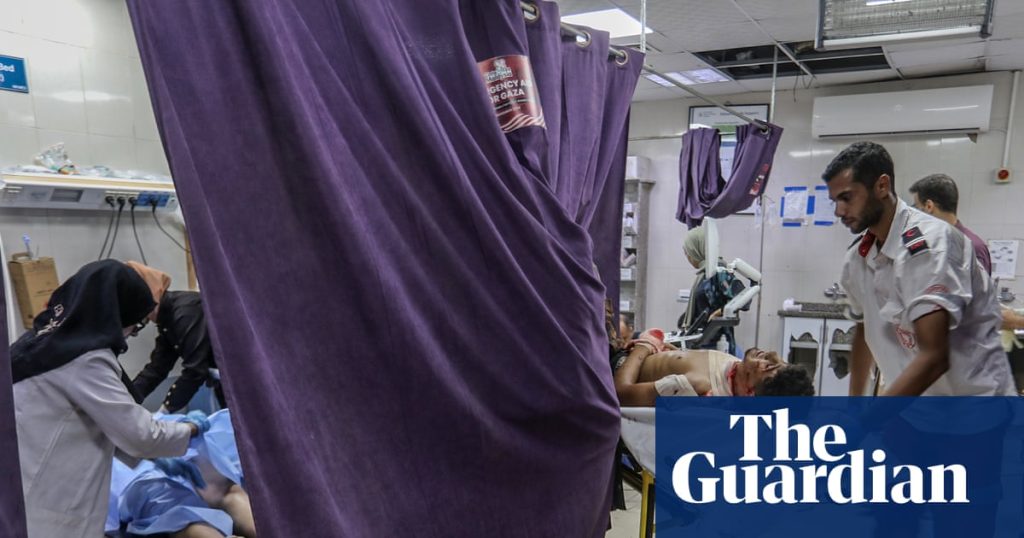In Gaza’s Nasser hospital, Mahmoud* lies with a gunshot wound to his left leg. His knee is shattered and the wound has become infected. The boy is writhing in pain but the doctors don’t have the painkillers to ease his suffering. He is given a nerve block, which stops him from feeling anything, and the relief allows him to sleep for a while. But once that wears off, the agony returns.
More than 167,000 Palestinians have been injured in Gaza since 7 October 2023, according to Gaza’s health ministry. From burns and blast wounds to lost limbs and fractured bones, Gaza’s hospitals have been overwhelmed by patients in profound pain.
But a desperate shortage of drugs means there is little doctors can do to help. Treatment and operations need to be carried out without proper anaesthetics, and what painkillers there are have to be rationed.
According to analysis by The Bureau of Investigative Journalism (TBIJ), more than half of the WHO’s medical missions into Gaza since January 2024 – including the delivery of medicines and fuel for hospitals, the deployment of staff and patient evacuations – have been denied, delayed, impeded or cancelled.
Meanwhile, Israeli forces have bombed storage facilities and hospitals, while international convoys of medical supplies are routinely blocked from entering Gaza or face weeks of delays at the border.
TBIJ spoke to eight doctors in Gaza who described the dire shortfall in pain relief drugs including opioids, anaesthetics, and even paracetamol.
“Most injuries are amputations or open fractures,” says orthopaedic doctor Abdelkareem Alsalqawi. “These are severely painful and require 24-hour painkillers. [But now] we tell them: one injection per day … use it at night so you can sleep.”
In July, the Israeli prime minister, Benjamin Netanyahu, said the country would be allowing “minimal humanitarian supplies” to enter Gaza. But aid agencies and doctors working in the territory report a near-total collapse of the medical supply chain.
“It is very clear that since March, we have spent months without allowing anything to enter,” says Dr Randa Abu Rabe of the WHO’s office for the occupied Palestinian territory. “It is not only the medication: it is the reagent, the diagnostics, some of the instruments or equipment.”
The Israeli government’s Coordinator of the Government Activities in the Territories (Cogat) says: “Israel allows and facilitates the entry of medical equipment and medicines, subject to prior coordination. As evidence, in recent weeks alone, more than 3,500 tons of medical equipment have been transferred.”
This is disputed by aid groups and doctors experiencing acute shortages. They say shipments are delayed for weeks or months at the border and requests are ignored.
Israel has never published a definitive official list of barred items but circulates shifting lists to international agencies.
Tania Hary, director of the legal centre Gisha, says shortages are aggravated by the collapse of secure delivery systems inside Gaza.
“In addition to restrictions [at the border], the breakdown in public order and looting has created barriers to getting aid in, including expensive and sensitive items like medicines and medical equipment,” Hary says. “The lack of availability cannot always be pinned neatly on restrictions at entry, but rather on barriers to distribution created by a host of factors – almost all of which can be traced to Israel’s conduct of the war and its policy on access.”
Travis Melin, a visiting US doctor in Gaza, says he is unable to understand the rationale behind drug restrictions. “Opioids are purely compassionate, they have no purpose other than compassionate care,” he says. “They don’t help you live longer, they don’t make you more likely to survive your injuries, they have no mortality benefit.”
Opioids have become tightly rationed. Doctors describe reducing patients to a single injection a day, leaving pain unalleviated for hours on end.
after newsletter promotion
In operating rooms, morphine, normally administered as a single sterile vial per patient, is so limited that doctors must treat several people from the same vial – a practice that carries infection risks.
Many opioids are classed as essential medicines by the WHO and their absence, doctors say, leaves patients and medical teams without the most reliable tools for managing acute pain and for allowing surgeons to work.
Gaza doctors often rely on ketamine, an anaesthetic with hallucinogenic effects, which they call a “battlefield medication”.
“If someone came in with an amputation, they would get an IV and then a dose of ketamine. It lasts about 45 minutes,” says Melin. “But giving it as a single dose, with the workforce here, is not feasible. And you can’t keep people [dosed with ketamine]. They can’t stand up, they can’t walk around, they can’t interact. So that’s not a safe option either.”
When it is available, doctors carry syringes pre-filled with ketamine for “mass casualty” events, when shelling brings in waves of patients, to inject small doses so that doctors can attend to them.
Patients frequently emerge hallucinating or terrified. And it wears off.
“Patients come into the ER and may or may not get a dose of ketamine. If they’re in pain but it’s not a catastrophic injury, they often won’t get anything,” says Melin. “For a severe injury or a procedure like inserting a chest tube, they’ll probably be given ketamine. But for something like a simple gunshot wound, most people are just toughing it out.”
Asked to comment, the Israeli government spokesperson said the Israel Defense Forces “will continue to act in order to facilitate medical care and the ongoing operation of medical institutions in the Gaza Strip, in cooperation with international aid organisations”.

